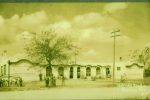Veterans Day Thoughts
By Capt. Dale Dye
USMC (Ret)
For years while in active military service, I spent a lot of time on radios. Mostly I was sending routine stuff like position fixes or situation reports that changed with every move. The response rarely changed. Charlie Mike, a voice of authority would reply. Continue Mission.
The meaning was clear if the words were brief. Just go ahead. Do what needs doing. It’s why you’re there. I’m thinking a lot about those words on Veterans Day 2024 as I watch, read, or listen to reports from storm-damaged states along our southeastern coast. What we’re seeing in those hurricane-ravaged areas of Texas, North Carolina, Louisiana, Florida, and Tennessee are groups of American military veterans continuing a mission.
Often you have to dig deep beyond superficial damage reports to find them doing such vital work among people devastated by disasters. They don’t blow their own horns or curry press coverage. They just do what needs to be done. They just Charlie Mike.
When state and local organizations are overwhelmed with requests for assistance, the veterans among us step up. When federal outfits like FEMA go broke or erect bureaucratic roadblocks, groups of unsung veterans maneuver around it all with a sense of perverse pride in flaunting the bureaucracy. They get on with the mission of helping people who need it now minus miles of frustrating red tape.
A classic example is Team Rubicon, a veteran-led nonprofit organization, that established and manned disaster relief operations in five states following the ravages of four deadly storms. Nobody in Florida or western North Carolina called them in to help. There is no magical bat-phone connecting outfits like Team Rubicon to hard-hit areas.
They see what needs to be done, and they do it. Most recently, 300 volunteers, most of them former military men and women, just showed up and went to work. Besides tools like chainsaws, shovels, and tarps, they brought compassion. They brought the spirit of service and selflessness that they adopted during their time in military uniforms.
One of the most valuable assets in disaster relief operations is air support. When roads are blocked, flooded, or unpassable, supplies and equipment must be brought in by air. And too often storms or other damaging events come with airport closures.
Enter the helicopter. Helicopters, pilots, and crews can go where others can’t, bringing in hands, equipment, and supplies. And they do it quickly without attendant clearances, delays, and dithering over who gets credit. I know from first-hand experience that’s also the nature of helicopter-support operations in the military. Nobody can get you there and keep you supplied? Just call the helicopter crews. They love this kind of stuff.
And they bring that spirit with them when flying in civilian ventures. An outstanding example is the Savage Freedoms Relief organization, an ad hoc private airbase from which daily rescue, reconnaissance, and resupply missions were flown throughout western North Carolina in the wake of hurricanes.
Started by a former Special Forces soldier and his fiancée, this aviation outfit was all over the area the minute storms passed. They mustered volunteers including private helo pilots, special operations and other military veterans, state guard people, and off-duty firefighters to set up an aerial operation akin to the Berlin airlift of 1948.
Adam Smith, the former green beret, gave some perspective on the size of the disaster relief operations. “We’ve had over 100 different helicopters and upwards of 200 pilots since this all started.” Think about that. Just the aviation fuel costs must have been staggering, not to mention wear and tear on pricey private aircraft.
Often, rotary-wing aircraft of all types, capabilities, and varieties were flown by veteran pilots who learned their skills at the controls of military helicopters. They knew a thing or two about flying in hazardous conditions and confined area landings. They were also adaptable and innovative, assets highly valued in the military.
Knowing how vital internet access has become in practically every aspect of society, helicopter pilots and crews flew in generators, fuel, and Starlink packages to some of the most remote areas damaged by the recent spate of storms. This kind of innovative thinking lets people communicate with worried families as well as indicate what kind of assistance they needed the most.
Military veterans think about things like that. They’ve spent a lot of time separated from concerned families and loved ones. They’ve learned what it’s like to live way out of your personal comfort zone. On and off battlefields, they learned the value and sense of purpose that comes with helping others.
This Veterans Day, I’m thinking about those people helping with storm damage and recovery. And I’m thinking about all the low-key ways our military veterans contribute every day in America. On occasions like this, we tend naturally to dwell on celebrated accomplishments by our veterans in wars around the world.
We tend to forget there are American military veterans all around us who still feel the need to contribute to our safety, health, and welfare in one form or another. Those should be among the ones we celebrate. Those are the selfless veterans who understand Charlie Mike. In or out of uniform, the mission continues.



